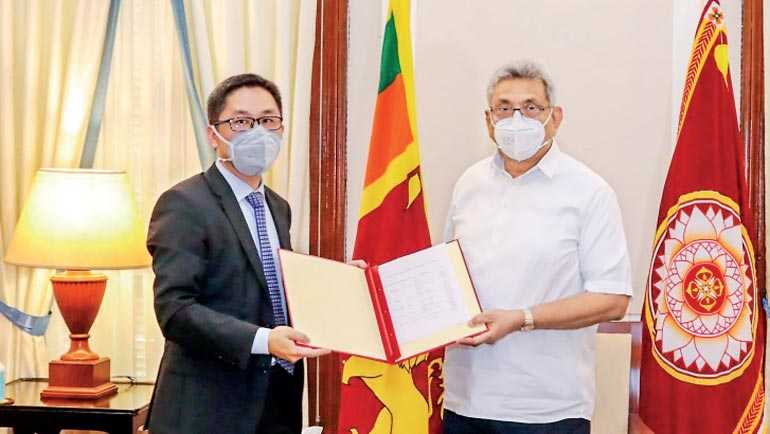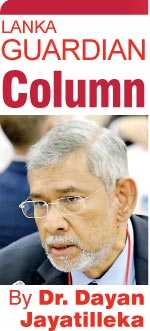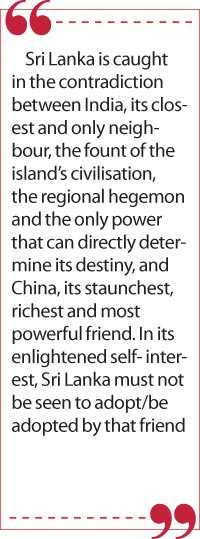Thursday Mar 13, 2025
Thursday Mar 13, 2025
Thursday, 25 June 2020 00:30 - - {{hitsCtrl.values.hits}}

The presentation of Chinese President Xi Jinping’s letter to President Gotabaya Rajapaksa
It was hardly a textbook example of the “correct handling of contradictions” (Mao). Future historians may conclude that the achievable dream of the 21st century as an Asian Age in a multipolar world order, died in mid-June 2020 in the Himalayas, in the Galwan valley in Ladakh.
The ferocious and lamentable clash between India and China with its tragic loss of lives is probably unlikely to escalate into armed conflict, but it marks a parting of the ways; the relationship will never be the same again. This rift will impact a number of important world forums and initiatives negatively. More fundamentally, it is certain to have inaugurated a fairly prolonged if low-intensity Cold War in Asia which will significantly impact and reshape global alignments and the overall strategic balance of forces in all regions, and most critically, the strategic dynamics in our own South Asian region.
World history today is being driven and will be driven in the foreseeable future by the relationship between the Great Powers—the USA, China and Russia—and the role that the Big Powers like India and emergent powers like Iran, Turkey and Indonesia play in relation to that Grand Triangle.
New dynamics
India is a pivotal power. While it is true that for the past 15 years India has shifted to a strategic partnership with the USA in relation to the rise of China and the “Indo-Pacific” region, India’s very size and self-image made it adopt a highly flexible role, giving itself as many openings as options as possible. This is a policy defined by India as “strategic autonomy”. Russia has always recognised and valued that role as authentic.
This role may undergo a reshaping after the recent clash with China, and India is likelier to enter a more cohesive grand strategic partnership with the USA, which can impact decidedly on the global balance, and enable the US to repair its damaged global architecture, restoring it to its leading international role if US voters are enlightened enough to replenish America’s vastly depleted “soft power” with a multilateralist Biden Presidency.
India has enormous soft power reserves in the world. It was elected to the UN Security Council this month with 184 of 193 votes, and on the previous occasion it was elected to the UNSC it beat Japan to that post. From West to East and North to South, India is well-regarded and respected “tous azimuths” –around all points of the compass.
Russia is the only power that can mediate between India and China, but it knows how touchy both can be, and it has important constituencies of friendship and intersection with each of the Asian giants in contention. Russia’s innovative, exploratory thinking around the concepts of “Eurasia” and “Greater Eurasia” will regrettably be off the table as long as there’s a latent or manifest Cold War between India and China.
There were also incidents between Chinese vessels and Vietnamese and Malaysian boats in 2019-2020. The clash in the Himalayas can shift India to a stand that explicitly endorses the strategic containment of China and even a grand-strategic attempt to rollback/pushback its influence.
With its economic power and civilisational cohesion China cannot suffer the centrifugal fate of the multinational USSR. However, India has the capacity to approximate that which China as a quasi-ally of the USA did to the assertive Soviet Union globally in the 1970s and 1980s.
It is very likely that the military-strategic relationship between India and the US, Australia, Japan, South Korea, and Vietnam will be enhanced, as well as with the Five Eyes grouping against China—US, UK, Australia, Canada, New Zealand.
Relations within BRICS will be negatively affected and the atmosphere if not the future of the Shanghai Cooperation Organization (SCO) is at stake.
A signal of the direction in which India’s strategic thinking may evolve, is available in a think piece by Nirupama Rao, regarded as an expert on India-China relations, former Foreign Secretary, former Ambassador to China and the USA and High Commissioner to Sri Lanka (enjoying a warm cordiality with President Mahinda Rajapaksa):
“…India’s leverage and balancing power within the Indo-Pacific and the world beyond…must be deployed much more effectively to counterbalance the Chinese ingress into this oceanic space that surrounds us…This is also an opportunity for India to align its interests much more strongly and unequivocally with the U.S. as a principal strategic partner and infuse more energy into its relations with Japan, Australia, and the ASEAN.” (https://www.thehindu.com/opinion/lead/galwan-postscript-to-a-tragedy/article31863515.ece)
The new dynamics will pose the most serious foreign policy challenge that any Sri Lankan government has faced in peacetime, and the incumbent administration as well as any successor administration will face for a few decades.
New history, Lanka’s dilemma
If the larger contest between the USA and China plays out in the most concentrated fashion in the Asia-Pacific region, or the larger ‘Indo-Pacific’ region, the recent clash showed that the cockpit of contradictions between the two Asian giants India and China, lies in South Asia itself. South Asia is where the contradictory strategic interests of the two are concentrated.
 |
 |
What the world faces is a low-intensity Asian Cold War within a new global Cold War between the USA and China, against the backdrop (at least initially) of a global economic downturn and political transitions.
In the new historical period that has just been inaugurated, Sri Lanka’s destiny will not be ultimately determined by the internal dynamics as decided upon by narrow nativists, petty autocrats and the local military machine—as their intrinsically circumscribed consciousness presumes—but by the global, continental and regional dynamics of Great Power rivalry and the alignment and role of Big/Pivotal/Emergent Powers within that Great Power rivalry.
The challenges to Sri Lanka are multiple and complex. Given its strategic location in the Indian Ocean region, already regarded a theatre of contestation, how does Sri Lanka avoid being caught up in these two concentric Cold Wars? How can a policy of equidistance be practically applied in a situation in which Sri Lanka is nothing like geographically equidistant between the two Asian giants?
On the one hand, states tend to use a friendly power far away to balance off a friendly power next door, because it is with one’s neighbour that contentious issues are more likely to arise (Kautilya). But on the other hand, it is the neighbour to whom one is most vulnerable, and more so when there is a vast asymmetry of sizes and strengths. This problem is heightened when the usual power balancing that a small state engages in assumes a different meaning in a changed context of intensified competition and friction.
In such a context, big powers tend to perceive the moves of small states through the prism of big power – and great power—struggle, and react or act preemptively according to such perceptions.
While discussions usually revolve around what Sri Lanka should do, it is perhaps more important to achieve clarity about what Sri Lanka should NOT do.
Sri Lanka is located on India’s Southern perimeter and after the recent clash on its Northern perimeter, India, as a big power which sees a global role for itself, will have a heightened strategic and security sensitivity to matters all around it, including on its Southern perimeter or flank.
In such a situation it is crucial that Sri Lanka not demonstrate or permit a demonstration of a privileged relationship with or preferential propensity for any of the two Asian contestants in this Cold War.
“Don’t do stupid stuff”
The official release of the President’s Office, following the visit of the Chinese Embassy delegation and the presentation of President Xi Jinping’s letter to President Gotabaya Rajapaksa as well as the greetings conveyed on his birthday, spotlighted a deepening relationship. Doubtless the letter and visit were in the pipeline well before the dreadful carnage in the Ladakh area, but it took place days after the incident.
In such a context, the Sri Lankan side should have been extra-cautious as to the potential signalling. The Presidential Secretariat release commenced by listing the following highlights:
President Xi sends birthday wishes to President Gotabaya
China and Sri Lanka successful in tracking COVID-19 patients because of the dedication of respective security forces and intelligence arm
China gifts health supplies to support Sri Lanka’s continuing battle against the virus
Investments and financial cooperation also discussed
The Presidential Secretariat release said, among other things: “…The Chinese delegation noted that both Sri Lanka and China followed a similar tracking system to identify potentially COVID-19 patients. Both countries were able to successfully tackle the crisis because of the dedicated efforts of their respective Security Forces and Intelligence officials….” (https://www.presidentsoffice.gov.lk/index.php/2020/06/18/president-xi-applauds-sri-lankas-successful-fight-against-covid-19/?lang=en)
What is signalled is special closeness, indeed overlap and affinity, in domestic policy/institutional models and practices. Such affinity, especially involving “security forces and intelligence” i.e. ‘hard power’, would imply, accurately or inaccurately, that China regards the Sri Lankan regime in a special, but not unique, category. It is a category of states which are to some degree under China’s umbrella or which China can count upon as assets. Pakistan, Cambodia and Myanmar are such states, which not incidentally, have a fairly distinct morphology. If the incumbent Lankan regime with its ‘Asiatic Authoritarian-militarist mode’ is perceived by India and the US as having transitioned to such a category of China’s “most favoured”, the consequences could be unfavourable.
President Barack Obama summed up the main rule of world affairs to a graduating class at West Point as “Don’t do stupid stuff”. In our case this would mean don’t spray-paint a target on your back. Obama also told Tel Aviv “friends don’t let friends drive drunk”. In our case it means that when a friend is driving drunk and involved in hit-and-run incidents with fellow Asians (including in our neighbourhood) don’t hitch a ride.
“Those who cannot remember the past are condemned to repeat it” (George Santayana). Navigating the bobbing sea-mines of the evolving India-China equation requires grasping the causes and chain of causation of India’s Sri Lanka policy in the 1980s. One aspect, which is readily admitted by the local nationalists is that Sri Lanka’s perceived tilt towards the USA generated a threat-perception in the mind of Delhi, which in its own interest rather than for reasons of ideology, leaned away from the US during the Cold War (and the Reaganite ‘New Cold War’ of the 1980s).
The underlying principle has yet to be grasped, namely that of India’s threat-perception regarding the role of external powers in its sphere of influence. Today, India considers China a far more adversarial power than it did the USA in the 1980s. Therefore, logically, if Colombo displays with China, President Jayewardene’s error of dalliance with the USA, the Indian threat-perception will be higher.
JN Dixit’s definitive lecture to the United Services Institute showed that the Tamil Nadu factor has a deep historical-geopolitical and strategic, not merely electoral-political importance. Tamil Nadu was the first state in which separatist sentiment appeared in India, and abated only with the India-China War of 1962 which led to a wave of pan-Indian patriotism. As Dixit pointed out, given the problems with Pakistan and China and the separatism on India’s Northern tier in several states, India had to keep its South stable and secure, and could not risk disaffection in Tamil Nadu over the plight of their ethnic kin, the Tamils of Sri Lanka, rekindling separatism if the people of Tamil Nadu felt that New Delhi/North India was impervious to the sufferings of the Tamils of Sri Lanka and by extension Tamils in general.
India and China are and will remain in strategic contention. Sri Lanka has a significant degree of Chinese influence, which assumes a different weightage in the post-Galwan strategic calculus. The Northeast of Sri Lanka which is geographically the closest parts of the island to India, is also majority Tamil-speaking as is the Southern tier state of India, Tamil Nadu, with a population of 80 million. In that the Tamils of Sri Lanka have an ethno-lingual and ethnoreligious affinity with India’s Southern tier state Tamil Nadu, they have by extension an affinity with India.
Great powers and Big powers consider enclaves of ethnic-kin across borders either as containing potential for dangerous contagion (hence Turkey’s incursion into Syrian and now Iraqi Kurdistan) or as defensive buffers/offsets against potential adversarial external moves (Russia in Georgia and the Ukraine). Big Powers tend to unfurl an umbrella over such areas/populations.
If Colombo seems to have a special closeness to China, post-Galwan, the Tamil majority areas of Northern Sri Lanka are likelier to appear as a potential buffer/hedge/offset than they did, pre-Galwan.
In the context of heightened rivalry, Big powers strive to ensure a preponderance of influence in states which fall within what they regard as their sphere of influence. In the case of some, this cannot be enforced (Cuba, Vietnam); in the case of others, especially those with “fault lines” it can. It is possible that India would either seek to deny/deprive China of a preponderance of influence in Sri Lanka or view Sri Lanka’s North and East as a sphere of influence in which India itself should enjoy a de facto preponderance of influence so as to offset China’s footprint in the South.
The Tamil issue on the island is not purely internal. It is ‘intermestic’ (Kissinger) i.e. at the interface of the domestic and the international. Today Colombo has neither a negotiation track with the Tamils nor a Mahinda-type ‘Troika’ with Delhi.
The mainstream media missed the landmark letter that Sampanthan addressed to the President with a copy to the PM, studiedly iterating the ancient Hindu heritage of the East—argumentation that could resonate with the BJP’s ‘Hindutva’—and sounding an alarm against unilateralist attempts to alter it. Huntington did list Sri Lanka as a site of a “fault-line” between Hindu and Buddhist civilisations.
It is strategically prudent for Sri Lanka to avoid any behaviour that generates an image or perception of over-dependence on, special affinity with or strategic adoption by China, because India’s enhanced, post-Galwan sensitivity to encirclement by China through proxies and Chinese influence on its strategically vital Southern perimeter will cause it to counter or pre-empt any potential for any such threat/power-projection by the perceived contender/adversary.
Sri Lanka is caught in the contradiction between India, its closest and only neighbour, the fount of the island’s civilisation, the regional hegemon and the only power that can directly determine its destiny, and China, its staunchest, richest and most powerful friend. In its enlightened self- interest, Sri Lanka must not be seen to adopt/be adopted by that friend.
Whether such self-constraint of sovereignty is fair, is irrelevant, as those familiar with The Melian Dialogue (between Athens and the leadership of the ‘neutral’ island of Melos) in Thucydides’ History of the Peloponnesian Wars—the foundational text of Realism—would know.
(Dr. Jayatilleka is a former Ambassador to Russia, France and Permanent Delegate to UNESCO, and Ambassador/Permanent Representative to the UN Geneva.)
Discover Kapruka, the leading online shopping platform in Sri Lanka, where you can conveniently send Gifts and Flowers to your loved ones for any event including Valentine ’s Day. Explore a wide range of popular Shopping Categories on Kapruka, including Toys, Groceries, Electronics, Birthday Cakes, Fruits, Chocolates, Flower Bouquets, Clothing, Watches, Lingerie, Gift Sets and Jewellery. Also if you’re interested in selling with Kapruka, Partner Central by Kapruka is the best solution to start with. Moreover, through Kapruka Global Shop, you can also enjoy the convenience of purchasing products from renowned platforms like Amazon and eBay and have them delivered to Sri Lanka.
Discover Kapruka, the leading online shopping platform in Sri Lanka, where you can conveniently send Gifts and Flowers to your loved ones for any event including Valentine ’s Day. Explore a wide range of popular Shopping Categories on Kapruka, including Toys, Groceries, Electronics, Birthday Cakes, Fruits, Chocolates, Flower Bouquets, Clothing, Watches, Lingerie, Gift Sets and Jewellery. Also if you’re interested in selling with Kapruka, Partner Central by Kapruka is the best solution to start with. Moreover, through Kapruka Global Shop, you can also enjoy the convenience of purchasing products from renowned platforms like Amazon and eBay and have them delivered to Sri Lanka.